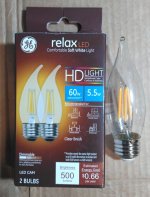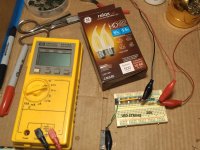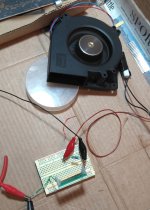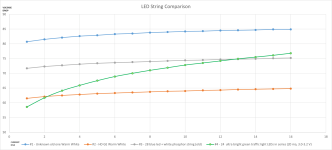It's close to an exponential curve of 155 uA at 0.5 V, increasing by a factor of ten for every 104.5 mV extra.
It's also reasonably close to 2.4991E-11*(V + 1)^38, which doesn't mean much, of course. I don't see how to make a parabolic curve close to it.
It's also reasonably close to 2.4991E-11*(V + 1)^38, which doesn't mean much, of course. I don't see how to make a parabolic curve close to it.
Last edited:
I had time for a quick test of a "known" LED string. This is a GE "HD Light", by looking at a few different ones it appears the LEDs are the same, just used in 2's, 4's or 6's in different profile bulbs. I choose the most useless of the lot I had to break open. The strings are VERY fragile, I suggest mounting it on standoffs on a piece of PC board, or something similar, right away.
First test was quick. The voltage drop was around 64V at 10ma, and before any other measurements I wanted to determine the max current. 4 strings, 5.5W /4 = 1.4W per string. 1.4W/64V = 22ma. So at least a place to start. Put it in series with a 10K resistor to allow the current to be measured with a voltmeter, and as "ballast". At 20ma it lit up quite brightly, and the rising plumes of smoke were kind of pretty too... 🙂. So obviously under 20ma. 16ma it could withstand for several minutes, I took this as a starting point.
Here is what I measured, and it was just the top part of the curve, but this is the only part that is interesting. Here's a table, I've not graphed it yet:
Current (ma) Voltage across LED string
16 63.6
15 63.5
14 63.4
13 63.4
12 63.3
11 63.2
10 63.2
That's as far as it goes for now. A couple of quick conclusion. One is that this string is obviously different than the first one I tested because the voltage drop is lower, but the general behavior is the same.
When I get a chance I'll try some more strings. Red, green and blue LED bulbs in this style are also available. Also "bright white", this one is "warm white", but I think this is a property of the phosphors and not the LEDs. Maybe...
First test was quick. The voltage drop was around 64V at 10ma, and before any other measurements I wanted to determine the max current. 4 strings, 5.5W /4 = 1.4W per string. 1.4W/64V = 22ma. So at least a place to start. Put it in series with a 10K resistor to allow the current to be measured with a voltmeter, and as "ballast". At 20ma it lit up quite brightly, and the rising plumes of smoke were kind of pretty too... 🙂. So obviously under 20ma. 16ma it could withstand for several minutes, I took this as a starting point.
Here is what I measured, and it was just the top part of the curve, but this is the only part that is interesting. Here's a table, I've not graphed it yet:
Current (ma) Voltage across LED string
16 63.6
15 63.5
14 63.4
13 63.4
12 63.3
11 63.2
10 63.2
That's as far as it goes for now. A couple of quick conclusion. One is that this string is obviously different than the first one I tested because the voltage drop is lower, but the general behavior is the same.
When I get a chance I'll try some more strings. Red, green and blue LED bulbs in this style are also available. Also "bright white", this one is "warm white", but I think this is a property of the phosphors and not the LEDs. Maybe...
Attachments
This voltage change with current is of the expected order of magnitude: between 12 and 24 mV per series connected LED for a 1.6:1 current ratio.
I found out the cause of the "constant voltage drop" with the LED string that started this thread. After testing two other elements and seeing more normal behavior, then going back to the first one tested, it still showed the "perfectly vertical" slope. The other two worked more like a bunch of LEDs in series.
All of the measurements I'd made were using a variac to raise and lower the voltage slowly. If instead the voltage was changed in quick steps the results were quite different for this part. After some fiddling it was apparent that the thermal coefficient for the LED string, and the temperature in free air at a given current, almost perfectly compensate the exponential diode curve. The other two are more normal, but I've changed the setup as shown in the picture and will take more measurements when I have the time.
As to whether the first LED string accidently has this match of properties, or it was engineered in for some reason, I've got no idea. But an LED string in a typical bulb is close to "free air" cooling, so maybe this was by design. Anyway it's unique to this one part (so far).
All of the measurements I'd made were using a variac to raise and lower the voltage slowly. If instead the voltage was changed in quick steps the results were quite different for this part. After some fiddling it was apparent that the thermal coefficient for the LED string, and the temperature in free air at a given current, almost perfectly compensate the exponential diode curve. The other two are more normal, but I've changed the setup as shown in the picture and will take more measurements when I have the time.
As to whether the first LED string accidently has this match of properties, or it was engineered in for some reason, I've got no idea. But an LED string in a typical bulb is close to "free air" cooling, so maybe this was by design. Anyway it's unique to this one part (so far).
Attachments
Does not say recommended for valve amps on the pack. There may be some sort of reification in the base or maybe the strings are different ways round. I would also imagine there's some sort of CCS there too or in one of the strings. They are designed to run off mains which can vary in voltage. Without a CCS the brightness would very a lot with the voltage. Not sure.
Last edited:
It would be interesting to know what happens between the Edison socket and the LED strings. Also, are the strings, in even numbers, wired alternately in opposite polarity? Is there a real resistor as current limiting? My upbringing keeps me from buying and smashing one open, but inquiring minds want to know. Could be construed as audio-related by the low dynamic impedance as possible voltage reference sources.
All good fortune,
Chris
All good fortune,
Chris
I have opened some Led bulbs that failed, due to bad quality soldering. They use a switching cinstant current source, as far as I see.
The "new" trend in America for ceiling lights is an integrated package, very shallow, with an aluminum base/heatsink, that hangs from the box and is the replaceable part - no Edison, 120VAC in on Romex, light out, base radiates heat within code. Makes me worry about the current source's working lifetime, but it could be a better paradigm after a century plus of Edison.
Why do these youngsters keep changing things? And, stop mumbling!
Chris
Why do these youngsters keep changing things? And, stop mumbling!
Chris
Phew!Does not say recommended for valve amps on the pack.
Normal cakes and decorations = $
"Wedding" cakes and decorations = $$$$$$$$$$ 😆
Btw I assume these are blue LEDs + yellow phosphor; no toying around with tri-colour LEDs? Maybe they could be used for some obscure bootstrapping part of a circuit as an alternative to an oversized capacitor? Or wherever a 60V drop could come in handy, but nobody wants to use a giant string of LEDs for it.There may be some sort of reification in the base or maybe the strings are different ways round. I would also imagine there's some sort of CCS there too or in one of the strings. They are designed to run off mains which can vary in voltage. Without a CCS the brightness would very a lot with the voltage. Not sure.
There is a subtext to the discussion: folk are using one or two series'd LEDs for cathode bias in 1 - 10 mA situations, somewhere on the knee, and no consensus has yet gelled about whether or not this falls within our audio canon, or is heresy. Thus the discussion of slope and dynamic impedance. If the slope at operating point is low enough its diode'y exponential contribution to local circuit resistance can be forgiven for its other virtues; if not, not. The higher the slope, the smaller its contribution to total resistance (and so, distortion), so a tentative figure of merit might be slope at a nominal current, say 1 and 3 and 10 mA, divided by voltage.
All good fortune,
Chris
All good fortune,
Chris
I have only used LED biasing a couple of times, and in both cases I added a resistor to "inject" additional current so the LED will be working at at least 10mA. Maybe it was not strictly necessary but I did that anyway, because all I could find were "generic" I/V curves for LEDs.
That's cheating! No fair to actually bias the diode into a better performing range.
All good fortune,
Chris
All good fortune,
Chris
I looked into this for my book. It turns out there is no need for extra 'feed current'. The LED nonlinearity is always so much less than the valve internal cathode impedance nonlinearity that the LED contiributes no measurable distortion (but it does add noise if it is not bypassed with a capacitor). In fact, extra feed current increases the bias voltage slightly, which makes valve distortion worse!If the slope at operating point is low enough its diode'y exponential contribution to local circuit resistance can be forgiven for its other virtues; if not, not. The higher the slope, the smaller its contribution to total resistance (and so, distortion),
It must take a really big capacitor to bypass such a low impedance. Looks like well under 10R at 10mA.
All good fortune,
Chris
All good fortune,
Chris
Here are the results of some testing with provision for cooling the LED strings. I've included as well the values for a string of 24 ultra bright green "traffic signal" LEDs I had around. This was for reference.
The results from the lamps are superior, obviously. But there are a couple of hitches to any practical use. I went back to Home Depot (popular US "big box" home improvement store) and found a whole new '24 LED lighting assortment. The technology is evolving so fast that even the shape and form of the LED strings are radically different, and there is a huge variety. Add to this that these are not spec'ed commercial parts and it gets kind of difficult to figure out how to use one even if you could.
Just the same, they are interesting devices...
Graph and data attached.
The results from the lamps are superior, obviously. But there are a couple of hitches to any practical use. I went back to Home Depot (popular US "big box" home improvement store) and found a whole new '24 LED lighting assortment. The technology is evolving so fast that even the shape and form of the LED strings are radically different, and there is a huge variety. Add to this that these are not spec'ed commercial parts and it gets kind of difficult to figure out how to use one even if you could.
Just the same, they are interesting devices...
Graph and data attached.
Attachments
Dissected some some "red filament" LED string lamps once they arrived from EBay and found that the red comes from the phosphor, not the LEDs. Electrically they appear almost identical to the "GE HD" ones in the graph.
- Home
- Amplifiers
- Tubes / Valves
- Uses for "filament bulb" style LED strings?



